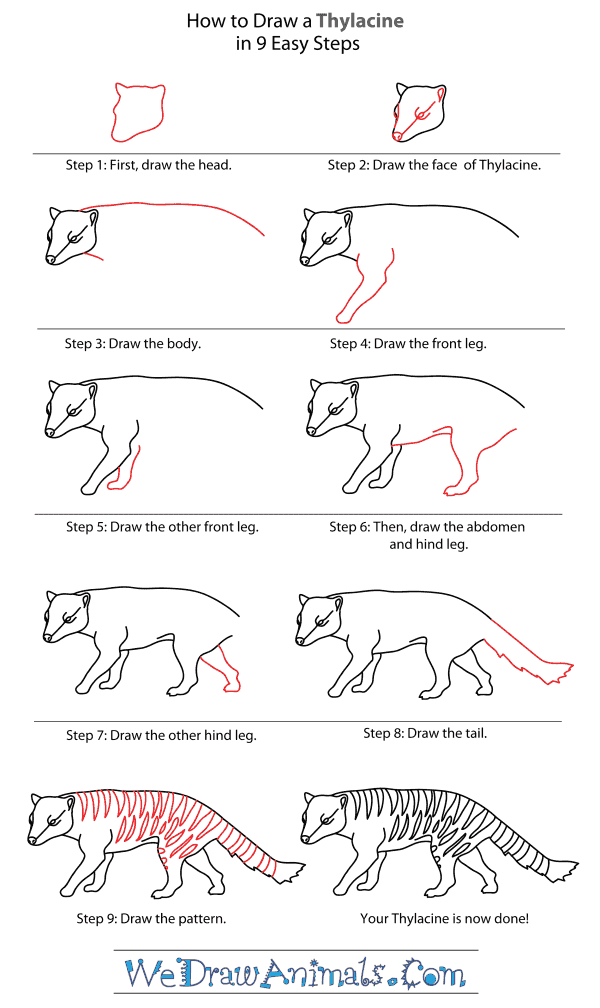In this quick tutorial you'll learn how to draw a Thylacine in 9 easy steps - great for kids and novice artists.
The images above represent how your finished drawing is going to look and the steps involved.
Below are the individual steps - you can click on each one for a High Resolution printable PDF version.
At the bottom you can read some interesting facts about the Thylacine.
Make sure you also check out any of the hundreds of drawing tutorials grouped by category.
How to Draw a Thylacine - Step-by-Step Tutorial
Step 1: When beginning your Thylacine drawing, you need to start with the head. To draw the head, draw two bumps at the top for the ears and larger bump at the bottom for the nose or mouth.
Step 2: Next you will want to add the facial features. Draw a circle for the nose and a circle with an arc around it for the eyes. Add a semi circle for the inside of the ear and a line coming from the nose through the eye.
Step 3: The next step is to draw the body. Starting at the top of the head draw a long curved line for the back. Then draw a short line coming out from the bottom of the head.
Step 4: Now draw the front leg. Using two curved lines and two straight lines, draw the front leg as shown above.
Step 5: Draw the other front leg the same as the first but coming out of the bottom of the body.
Step 6: Next you will want to draw the abdomen and the hind leg. For the abdomen draw a curved line coming from the front leg to the back. For the hind leg use curved lines for the upper part and straight lines to create the lower part of the leg.
Step 7: Draw the other hind leg the same as the first but have it come out of the back of the body at an angle.
Step 8: Now you will want to draw the tail, by drawing a straight line for the top of the tail and a jagged line for the bottom and have them meet at an angle.
Step 9: For the final step, you will need to draw the pattern on the body. Use triangle shapes to create the pattern on the main part of the body and rectangular shapes on the tail to create the pattern shown above. You have now successfully drawn a Thylacine.
Interesting Facts about the THYLACINE
The Thylacine is a member of the canine family and the scientific term for them is Thylacinus cynocephalus. The scientific name is Greek for “dog-headed pouched one.” Another common name for this species is the Tasmanian Tiger. It gets its name from the stripes on its back, and was the largest carnivorous marsupial. They were native to Australia, Tasmania, and New Guinea. It was an excellent predator, able to survive in wastelands.
Did you know?
- They were also called Tasmanian Wolf.
- The animal was first documented in 1808.
- They’re survived by their closest living relative, the Tasmanian Devil.
- This animal hasn’t been reported since the 20th Century.
- They were 1 of 2 animals where both sexes possessed a pouch on their abdomen like a kangaroo.
Like this animal, opossums had pouches in both genders. A pending project is designed to clone this animal. Although sightings of this species have been claimed, none are currently confirmed. Encroachment by humans, their dogs, and disease, is primarily blamed for its disappearance, but hunters may have received bounties for capturing this creature. Since there have been no recently verifiable reports of these creatures, they are considered to be extinct.










